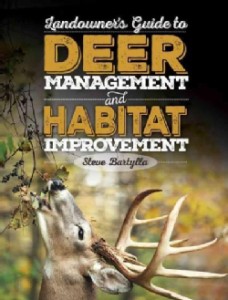
Steve Bartylla talks Hinge Cutting
Steve Bartylla talks Hinge Cutting
Bonus Tip of the Day
Brought to you by:
Antler King Trophy Products Inc., Custom Robotic Wildlife, Inc., Easton Archery, Heater Body Suit, Inc, Hunter Safety System, Mathews Archery, Inc., Redneck Hunting Blinds, RECONYX, Wildlife Research Center, inc. &Bartylla’s aerial photo evaluations
I’m typically not going to be doing these on weekends, but, if all goes as planned (these things don’t for me almost as much as they do…so, I try to always remain rigidly flexible), I’ll be working at a client’s most of next week. So, I’ll merely be doing a tip of the week on Monday….IF all goes as planned.
https://www.facebook.com/steve.bartylla/videos/712921502223114/
This one is going to be little things on hinge cutting (cutting trees far enough through so that they fall, yet the top retains a connection with the base…the connective tissue the remains uncut and acts as a “hinge”). PLEASE never look to me for instruction on how to actually hinge cut. I’ve found what works best for me, but I am NOT a professional logger and most certainly am NOT the most qualified person to teach safe cutting methods.
I’ll say a couple things on safety upfront, though. The first is don’t make the same mistake I did and get cocky. I was either 10 or 11 when my uncle first drug me into the woods with him, chainsaws in hand. I’ve been using chainsaws ever since, and was way too dang cool to wear chaps, helmet and so on….Until about 5 years ago, when hinge cutting by myself smack dab in the middle of 1550 acres of timber. I’d been cutting for 8ish hours already, in 90 something degree temps…I was almost done and rushing to finish, so I could move on to other tasks. The saw kicked and cut through my jeans, the front pocket of my jeans and left a 4ish inch gash in my boxers (not to get overly personal, but I don’t wear baggy boxers).
Steve Bartylla talks Hinge Cutting
Not trying to get preachy, but there’s an old saying, “God looks out for children and fools.” I’ve added, “and I obviously have the back end covered.” No matter how long you’ve been working with chainsaws, respect them. Follow all the safety rules and NEVER cut trees that make you nervous for any reason….it’s just not worth it. I did get flat out lucky. I never even broke the skin. Losers rely on luck. Winners make their own. In this case, by following safety rules religiously.

One tip right off the bat, Jim Brauker has done some good work on how to hinge cut. We have some differences. I personally don’t use a hook (hate dragging the thing around with me) and only use wedges on rare occasions (again, I leave them on the ATV, as I hate dragging stuff around with me), but his methods for cutting and such are solid. Look his youtube videos up, if you need instruction on how to hinge cut or simply want a refresher.
When hinging the larger trees (any tree that would hurt if it fell on you), always select at least 2 escape routes before beginning the cut and take one of them as soon as that tree starts to give. Watching it fall from 10 yards away is a LOT safer than standing next to it, as it falls.
Don’t hinge cut in overly deep snows or when the temps are in the low teens or less. The snow depth is to avoid tripping over covered branches and such. Danger issue. The colder temps are because it makes trees brittle and they have a higher tendency to snap.
Steve Bartylla talks Hinge Cutting
A lot of trees hinge better than others and some are going to snap dang near every time. If there is a comprehensive list, I’m unaware of it, as there are just so dang many tree species spread across North America. The snappers, such as aspen that populate so much of the north, just aren’t worth it. If you need to open the canopy, do traditional cuts on the larger species, prone to snapping. When they kick out, well, it’s hard to get a much more dangerous situation (which is why I suggest taking escape routes the second large trees start to go…..GREATLY reduces risks)
Steve Bartylla talks Hinge Cutting
Most often, one will be hinging a bunch of trees in an area. Start with the biggest trees you’ll be hinging first. doing so helps reduce hang ups and flattening the hinge cut trees they’d fall on. This is particularly important when creating bedding areas. By dropping the big ones, you can create an artificial ceiling by laying the smaller ones on top of the bigger ones.
The more connective tissue that remains (the lesser the cut) the higher the tree’s survival rate tends to be. On the trees I’m not worried about hurting me, I only cut 40-70% of the way through and pull them over.

One thing I’ve noticed in a lot of hinge cut pictures and videos is that many tend to cut way too low for bedding areas. Vary the height of the cut for the purpose you’re trying to achieve. When making hinge cut bedding areas, cut chest high. For blockades, vary the height from chest to knee height to make it so they can’t as easily jump over or crawl under. Edge feathering around openings, I tend to go chest to waist, as it helps screen the plot.
Most importantly, when you either get tired or it turns into work, stop. That’s when accidents tend to happen. Besides, this is supposed to be fun! If it’s not, don’t do it.
Tree survival rates will vary wildly, based on a host of factors. Sure, we want them to live, as a living tree produces browse and better cover. That said, even when they die, an open canopy does a wonderful job of spurring new growth, with is desperately needed in more mature, open woods.
Hinge cutting isn’t the end all, be all of habitat improvement. You can accomplish similar results through TSI and plantings. In fact, one is often best off having larger areas logged first, leaving the tops where they lay, and hinge cutting after the loggers have left (money in your pocket and the trees they will be taking are often too big to hinge safely, anyway).
Hinge cutting can be a very effective means of increasing browse (big increase in woody browse, between the tops at ground level and new growth) and cover (bedding, safety and forcing bucks to waste more time on your grounds looking for does), as well as creating screens (hiding you from deer and deer from each other, reducing social stress and again forcing bucks to waste more time on your ground looking for does) and blockades (funneling deer, increasing browse and screening), just to name the biggies.
Finally doing Christmas with the kids this weekend. So, I won’t be able to answer many ?s ASAP, but I’ll try to get to them…..Just remember to have fun and be safe. A deer isn’t worth getting seriously injured over or worse.




